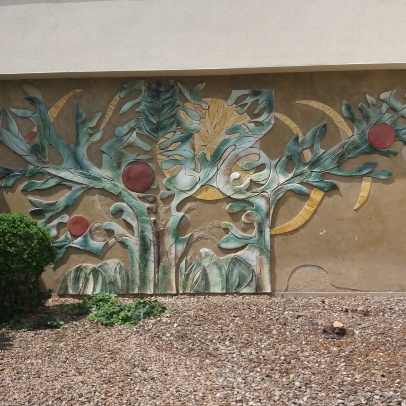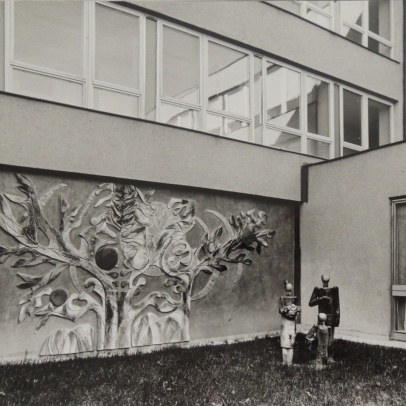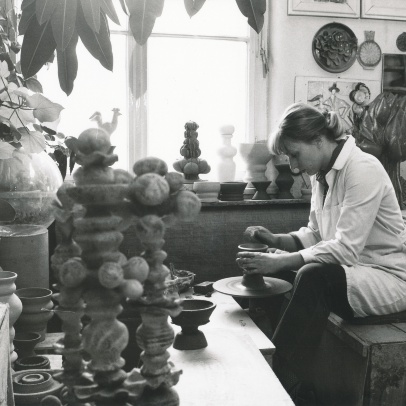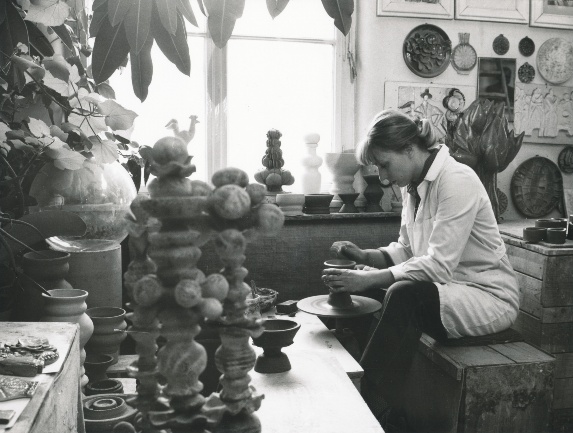Name: The World of Children / The Tree
Author: Jana Chrásková
Dating: 1975–1976
Location: in the exterior in the atrium of the former Ludvík Podéště Primary School in Ostrava-Poruba, today the Faculty of Civil Engineering, VŠB – Technical University of Ostrava
Execution: a relief mosaic and a sculptural group made of glazed ceramics; mosaic dimensions 300 x 900 cm, the sculptural group has been removed
THE WORLD OF CHILDREN IN THE WORLD OF STUDENTS
Together with the development of VŠB – Technical University of Ostrava, the University campus has inevitably expanded, not only through extensions of new buildings but also through existing buildings that had previously lost their original purpose. Since the actual school building is not necessarily determined by the level of education attained in it (every school consisting mainly of corridors and classrooms), the conversion of lower-primary schools into a university building seemed the least problematic. VŠB-TUO thus acquired the premises of two former primary schools. The building of the primary school at Ludvík Podéště Street in Ostrava-Poruba changed to the Faculty of Civil Engineering in 1998 (it was later expanded by the extensions) and the work decorating the building for primary school pupils became part of the university environment.
The school building at the westernmost tip of Ostrava-Poruba was decorated with a relief mosaic and sculptures by Opava artist Jana Chrásková (*1948) in 1975–1976. Chrásková has always focused on working with ceramics. She is the author of a series of reliefs, sculptures and jardinieres that reveal a woman’s perception of the world are characterized by a lyrical touch and smooth transitions of colours that often originate from glaze spraying. She seems to prefer warm, earth tones that combine with gentle or blurry, cold colour tones (especially blue). In terms of the subject, the author usually stays within the limits of civilian sculptural themes of the second half of the 20th century (flowers and harvest, animals, female faces and figures). Such works are also included, in essence, in the relief mosaic accompanied with a sculptural group for the primary school in Ostrava-Poruba, which represent her first work for architecture.
The wall-mounted art for the enclosed atrium by the entrance to the school is on the boundary between a mosaic and a relief. It is rather flat and composed of smaller ceramic pieces (which corresponds to the mosaic concept), but because it does not cover the entire wall, and projects from it as a bas-relief (later Chrásková’s works have, in most cases, the surface of the ceramics embossed, so they are pure reliefs). The work of art represents a stylized tree with two round red fruits and a ball of the same colour, which looks like the third, somewhat larger fruit at first glance. Another complementary circular motif is the sun in the background of the tree. A stylized sculptural family group in ceramics shaped on the potter's wheel situated on the right side in front of the areal element on the wall contrasted with it in its plasticity. The figures are shown in their traditional roles – a father-mechanic with a double-sided key, a mother-breadwinner with a basket of fruit and vegetables, and a baby with a ball. The growing and fruit-bearing tree illuminated by the sun in connection with the ball, the child, and the family referred not only to its natural archetype but also suggested one of the favourite children’s playgrounds, symbolizing the development of the child and the family tree of life.
Following the change in building use, this situation was disturbed by the removal of the figurative element, which perhaps seemed unsuitable to a new user in connection with the University facility. Thus only the wall element remained in the atrium – the tree with the ball, whose role in the composition suddenly seemed surrounded by mystery. In connection with the conversion of the atrium into a small, enclosed garden, however, the natural element on the wall does not deviate in any way and does not appear to give a childish impression in the university environment by its formal design. On the contrary, it continues to refresh the University’s sober architecture with its organic shapes and spring colours.



